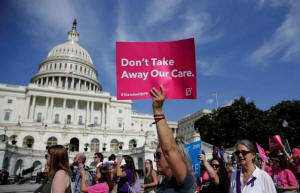|
Hundreds of counties at risk for no
Obamacare insurer in 2018
 Send a link to a friend
Send a link to a friend
 [July 29, 2017]
By Caroline Humer [July 29, 2017]
By Caroline Humer
NEW YORK (Reuters) - With Republican
efforts to dismantle Obamacare in disarray, hundreds of U.S. counties
are at risk of losing access to private health coverage in 2018 as
insurers consider pulling out of those markets in the coming months.
Republican senators failed this week to repeal and replace Obamacare,
former President Barack Obama's signature healthcare reform law,
creating new uncertainty over how the program providing health benefits
to 20 million Americans will be funded and managed in 2018.
In response, Republican President Donald Trump on Friday again suggested
that his administration would let the Obamacare program “implode.” He
has weakened enforcement of the law’s requirement for individuals to buy
insurance, threatened to cut off funding and sought to change plan
benefits through regulations.
Anthem Inc, Cigna Corp, Health Care Service Corp and Molina Healthcare,
four of the biggest health insurers selling Obamacare plans, said they
are weighing whether to pull out of more markets for 2018 rather than
face financial losses. They have until Sept. 27 to finalize their plans.

So far, 40 U.S. counties are expected to have no insurer offering
individual coverage next year, but that number could rise by the
hundreds, according to U.S. government data, Kaiser Family Foundation
analysis and insurer disclosures. More than 1,300 counties, primarily in
15 states, currently have only one insurer participating in 2018. Anthem
and HCSC are the last man standing in one-third of those counties and
states - putting those areas in particular at risk.
“Right now the number of counties at immediate risk of having no
insurers in 2018 is small, but it could easily grow significantly if a
couple major insurers decide to exit,” Larry Levitt, health economist at
the Kaiser Family Foundation, said.
Many insurers have been waiting for an answer from Trump or lawmakers on
whether they will continue to fund $8 billion in annual government
subsidies. Without assurances, many insurers plan to raise rates an
additional 20 percent by an Aug. 16 deadline for premium prices. Others
say that the many unknowns will make the business too risky.
The last-minute drama has left millions of Americans questioning whether
they will have medical coverage next year.
Julie Grady, a 59-year-old small business owner in Carson City, Nevada,
is currently covered by Blue Cross Blue Shield of Nevada, part of
Anthem, which has already decided to leave the exchanges in her county
and most of the state. Carson City will have no insurer on the exchanges
next year.
Grady’s pays a reduced premium of $70 per month and a deductible under
$1,000 for her plan, which is part of the Affordable Care Act, commonly
called Obamacare. Grady is looking at being uninsured, as she was before
the law.

“I would have to go without health insurance,” she said. “I would just
stay healthy, hike, eat well. I’d be in trouble if something
catastrophic happened. I would lose everything.”
ANTHEM CONSIDERING 2018 PLANS
Anthem, the second-largest U.S. health insurer, sells Blue Cross Blue
Shield plans in 14 states. It has already decided to pull out of most
individual markets in Nevada, Ohio, Indiana and Wisconsin in 2018.
Earlier this week, Chief Executive Officer Joe Swedish said he was still
weighing 2018 participation in its other states.
[to top of second column] |

Healthcare activists with Planned Parenthood and the Center for
American Progress protest in opposition to the Senate Republican
healthcare bill on Capitol Hill in Washington, U.S., June 28, 2017.
REUTERS/Joshua Roberts

In states like Colorado, Georgia, Kentucky, Missouri, and Virginia,
Anthem sells plans in more than 250 counties where it is the only
insurer, and they could be left "bare" next year, according to
government data.
Health Care Services Corp is a Blue Cross Blue Shield licensee in
five states and is the only Obamacare individual insurer in more
than 90 Texas counties, more than 75 Oklahoma counties, and half a
dozen Illinois counties. It confirmed on Friday that it has
submitted products for its five states but is still weighing next
year.
"We’re working through the regulatory filing process and hope to
fully participate...in 2018, however no final decisions have been
made," HCSC spokeswoman Kristen Cunningham said.
Molina, which has more than 1 million members in Obamacare plans,
and Cigna, with more than 250,000 participants, have said they need
more certainty from the government to decide on 2018 participation
and would weigh their decisions up until the late September
deadline.
State insurance regulators have worked hard in recent months to
replace insurers who have left. In Nevada, for instance, Centene
Corp and Aetna Inc entered in some counties that Anthem left after
the insurance commissioner said he would favor these insurers for
its Medicaid contract bids.
But they are unlikely to find replacements for new dropouts in these
final weeks, particularly if the Trump administration signals it
won’t fund $8 billion in subsidies for out-of-pocket medical costs.

"There is almost no chance they would step in to participate," said
Kurt Wrobel, a fellow at the Society of Actuaries and chief
financial officer of the Geisinger Health Plan in Pennsylvania.
Some insurers say they will likely just raise rates and hope it
works. Blue Cross Blue Shield of Michigan filed two sets of rates
with the state department of insurance, one up to 32 percent higher
if the fate of subsidies remains unclear.
"We don't have any plans to pull out,” said Rick Notter, director of
the individual business at BCBS Michigan. “But it would certainly
help to have more certainty around what the market holds."
(Additional reporting by Jilian Mincer; Editing by Michele Gershberg
and Cynthia Osterman)
[© 2017 Thomson Reuters. All rights
reserved.]
Copyright 2017 Reuters. All rights reserved. This material may not be published,
broadcast, rewritten or redistributed.
 |